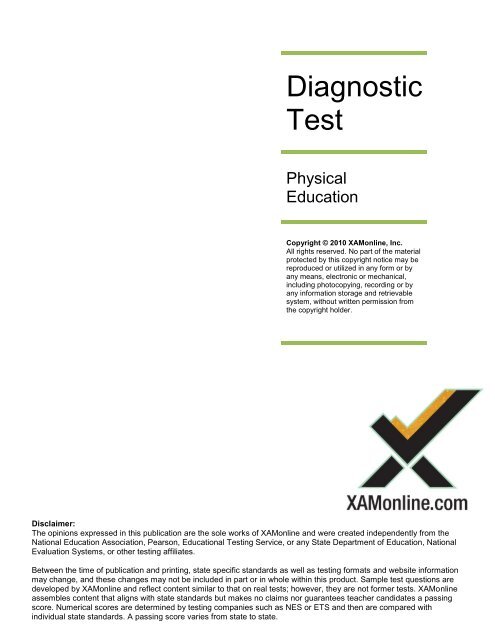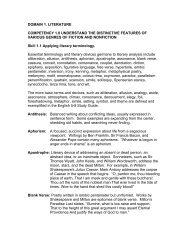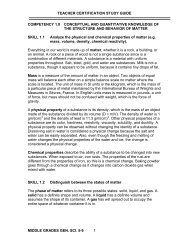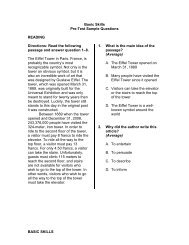Diagnostic Test
Diagnostic Test - XAMOnline.com
Diagnostic Test - XAMOnline.com
You also want an ePaper? Increase the reach of your titles
YUMPU automatically turns print PDFs into web optimized ePapers that Google loves.
<strong>Diagnostic</strong><strong>Test</strong>PhysicalEducationCopyright © 2010 XAMonline, Inc.All rights reserved. No part of the materialprotected by this copyright notice may bereproduced or utilized in any form or byany means, electronic or mechanical,including photocopying, recording or byany information storage and retrievablesystem, without written permission fromthe copyright holder.Disclaimer:The opinions expressed in this publication are the sole works of XAMonline and were created independently from theNational Education Association, Pearson, Educational <strong>Test</strong>ing Service, or any State Department of Education, NationalEvaluation Systems, or other testing affiliates.Between the time of publication and printing, state specific standards as well as testing formats and website informationmay change, and these changes may not be included in part or in whole within this product. Sample test questions aredeveloped by XAMonline and reflect content similar to that on real tests; however, they are not former tests. XAMonlineassembles content1 | Copyright that aligns © 2010 with XAMonline, state standards Inc. but makes no claims nor guarantees www.XAMonline.comteacher candidates a passingscore. Numerical scores are determined by testing companies such as NES or ETS and then are compared withindividual state standards. A passing score varies from state to state.
XAMonline: Providing teachers with superior certification study toolsAre you looking for a comprehensive study guide to help you pass the teachercertification exam the first time? Do you want a guide that is aligned with currenttest guidelines, one that includes the exact information without the fluff?XAMonline’s teacher certification study guides offer an easy-to-understand, indepthreview of the actual content that’s on the test. Unlike other study guidesXAMonline provides the actual content, not just a list of a skills and competenciesor study secrets.In addition to a thorough review, our guidesinclude practice tests with up to 125 questions toprepare you for the actual exam. The practicetests include full answer rationales as well as skillreference and rigor for each question, allowingyou to quickly flip back and review the relevantcontent and identify which topics to devote morestudy time to.Do you want a guide that is alignedwith current test guidelines, onethat includes the exact informationwithout the fluff?XAMonline guides are designed to prepare you for success, on both yourcertification test and in the classroom.Developed by a teacher, for teachersFounded in 1996, XAMonline began with one teacher-in-training who wasfrustrated by the lack of materials available for teacher certification exampreparation. From a single state-specific guide, XAMonline has grown to offerover 300 study guides for every state exam, as well as the PRAXIS I andPRAXIS II tests.Our comprehensive study guides offer more than just the required certificationcompetencies and skills. Their content and structure enables you to go beyondbasic skills development and rote memorization to mastery of subject matter, anecessary trait of effective teaching. The content of our PRAXIS and statespecificguides is aligned and weighted to current standards, ensuring you’restudying the right material.Quality Content from Quality Teaching ProfessionalsXAMonline’s superior quality standards are maintained by seasoned,professional teachers. We choose from a pool of over 1,500 certified teachers towrite, review, and edit our guides. Each certification study guide includes anextensive practice test, which features varied levels of rigor and in-depth answerrationale. Just like the study guide, the practice test questions are aligned withthe current state or PRAXIS test parameters, providing you with an experiencethat parallels the real test.2 | Copyright © 2010 XAMonline, Inc. www.XAMonline.com
<strong>Test</strong>ing Tips1. Do not read anything into the question. Do not assume that the testwriter is looking for something else than what is asked. Stick to thequestion as written and do not read extra things into it.2. Read the question and all the choices twice before answering thequestion. You may miss something by not carefully reading and then rereadingboth the question and the answers. If you really do not have aclue as to the right answer, leave it blank on the first time through. Go onto the other questions, as they may provide a clue as to how to answer theskipped questions. If later on, you still cannot answer the skippedones…guess. The only penalty for guessing is that you might get it wrong.Only one thing is certain; if you do not put anything down, you will get itwrong!3. Turn the question into a statement. Look at the wording of thequestions. The syntax of the question usually provides a clue. Does itseem more familiar as a statement rather than as a question? Does itsound strange? By turning a question into a statement, you may be ableto spot if an answer sounds right, and it may trigger memories of materialyou have read.4. Look for hidden clues. It is actually very difficult to compose multiple-foil(choice) questions without giving away part of the answer in the optionspresented. In most multiple-choice questions, you can often readilyeliminate one or two of the potential answers. This leaves you with onlytwo real possibilities and automatically your odds go to fifty-fifty for verylittle work.5. Trust your instincts. For every fact that you have read, yousubconsciously retain something of that knowledge. On questions aboutwhich you are not really certain, go with your basic instincts. Your firstimpression on how to answer a question is usually correct.6. Mark your answers directly on the test booklet. Do not bother trying tofill in the optical scan sheet on the first pass through the test. Mark youranswers carefully when you transcribe them to the scan sheet.7. Watch the clock! You have a set amount of time to answer the questions.Do not get bogged down trying to answer a single question at the expenseof ten questions you can more readily answer.3 | Copyright © 2010 XAMonline, Inc. www.XAMonline.com
1. Using the same foot to take offfrom a surface and land iswhich locomotor skill?(Easy)A. JumpingB. VaultingC. LeapingD. Hopping2. What is the proper order ofsequential development for theacquisition of locomotorskills?(Rigorous)A. Creep, crawl, walk, jump, run,slide, gallop, hop, leap, skip;step-hop.B. Crawl, walk, creep, slide,walk, run, hop, leap, gallop,skip; step-hop.C. Creep, crawl, walk, slide, run,hop, leap, skip, gallop, jump;step-hop.D. Crawl, creep, walk, run, jump,hop, gallop, slide, leap, skip;step-hop.3. Which of the following bodytypes is the most capable ofmotor performance involvingendurance?(Average Rigor)A. EndomorphB. EctomorphC. MesomorphD. Metamorph4. What was the first state in theU.S. to require P.E. in its publicschools?(Average Rigor)A. FloridaB. MassachusettsC. New YorkD. California5. For a movement to occur,applied force must overcomeinertia of an object and anyother resisting forces. Whatconcept of force does thisdescribe?(Rigorous)A. Potential energyB. MagnitudeC. Kinetic energyD. Absorption4 | Copyright © 2010 XAMonline, Inc. www.XAMonline.com
6. All of the following areSystematic ObservationalEvaluations except:(Rigorous)A. Reflective RecordingB. Event RecordingC. Duration RecordingD. Self Recording7. Title IX ensured that:(Easy)A. Boys play baseball while girlsplay softballB. Girls are ensured the sameeducational and athleticopportunities as boysC. Girls and boys have coedphysical education classesD. All students must dress out forphysical education class8. A physical education instructoranticipates and preventspotential injuries, watches forhidden injuries, and takes aninjury evaluation of the entireclass. Which of the followingstrategies to prevent injuries isthe teacher demonstrating?(Average Rigor)A. Maintaining hiring standardsB. Proper use of equipmentC. Proper procedures foremergenciesD. Participant screening9. Which of the following is not aconsideration for the selectionof a facility?(Rigorous)A. Community involvementB. Custodial staffC. Availability to women,minorities, and thehandicappedD. Bond issues5 | Copyright © 2010 XAMonline, Inc. www.XAMonline.com
10. Long-term planning isessential for effective classmanagement. Identify themanagement techniques notessential to long-termplanning.(Easy)A. Parental observationB. Progress evaluationC. Precise activity planningD. Arrangements for linemarkings12. Instructors can assess skilllevel achievement in bowlingby:(Easy)A. Calculating a student'saverage score.B. Calculating how many gutterballsthe student threw.C. Calculating how many strikesthe student threw.D. Calculating how many sparesthe student threw.11. Process assessment does notidentify which of the followingerrors in skill performance.(Average Rigor)A. StyleB. FormC. End resultD. Mechanics13. A bowling pin that remainsstanding after an apparentlyperfect hit is called a:(Rigorous)A. TapB. TurkeyC. BlowD. Leave14. Playing "Simon Says" andhaving students touch differentbody parts applies whichmovement concept?(Average Rigor)A. Spatial AwarenessB. Effort AwarenessC. Body AwarenessD. Motion Awareness6 | Copyright © 2010 XAMonline, Inc. www.XAMonline.com
15. An obese student's fitnessassessments were poor forevery component of fitness.Which would you recommendfirst?(Easy)A. A jogging program.B. A weight lifting program.C. A walking program.D. A stretching program.16. Which manipulative skill usesthe hands to stop themomentum of an object?(Rigorous)A. TrappingB. CatchingC. StrikingD. Rolling17. Which professionalorganization protects amateursports from corruption?(Easy)A. AIWAB. AAHPERDC. NCAAD. AAU18. Research in physical educationis published in all of thefollowing periodicals exceptthe:(Average Rigor)A. School PE UpdateB. Research QuarterlyC. Journal of Physical EducationD. YMCA Magazine19. Students are performing thevertical jump. What componentof fitness does this activityassess? (Rigorous)A. Muscle strengthB. BalanceC. PowerD. Muscle endurance20. With regard to protein content,foods from animal sources areusually:(Average Rigor)A. CompleteB. EssentialC. NonessentialD. Incidental7 | Copyright © 2010 XAMonline, Inc. www.XAMonline.com
21. Which of the following is not atype of meet?(Average Rigor)A. ExtramuralB. IntramuralC. InterscholasticD. Ladder22. Activities to specificallydevelop cardiovascular fitnessmust be:(Rigorous)A. Performed without developingan oxygen debtB. Performed twice daily.C. Performed every day.D. Performed for a minimum of10 minutes.23. Which is not a sign of stress?(Average Rigor)A. IrritabilityB. AssertivenessC. InsomniaD. Stomach problems24. Prior to activity, studentsperform a 5-10 minute warmup.Which is not recommendedas part of the warm-up?(Easy)A. Using the muscles that will beutilized in the followingactivity.B. Using a gradual aerobicwarm-up.C. Using a gradual anaerobicwarm-up.D. Stretching the major musclegroups to be used in theactivity.25. Students on a running programto improve cardio-respiratoryfitness apply which exerciseprinciple?(Rigorous)A. AerobicB. ProgressionC. SpecificityD. Overload26. Which is not a benefit ofcooling down?(Rigorous)A. Preventing dizziness.B. Redistributing circulation.C. Removing lactic acid.D. Removing myoglobin.8 | Copyright © 2010 XAMonline, Inc. www.XAMonline.com
27. A student playing badmintonbelieved that the shuttlecockwas going to land out-ofbounds.The shuttlecocklanded on the line. What is thecorrect ruling?(Easy)A. The shuttlecock is out-ofbounds.B. The shuttlecock is in-bounds.C. The point is replayed.D. That player is charged with afeint.28. The ball served in racquetballhits the front line and lands infront of the short line. What isthe ruling?(Easy)A. FaultB. ReserveC. Out-of-bounds29. All of the following aremethods to evaluate theaffective domain except:(Average Rigor)A. Adams Prosocial InventoryB. Crowell Personal DistanceScaleC. Blanchard Behavior RatingScaleD. McCloy's Prosocial BehaviorScale30. Which of the following is not askill assessment test toevaluate student performance?(Average Rigor)A. Harrocks VolleyB. Rodgers Strength <strong>Test</strong>C. Iowa Brace <strong>Test</strong>D. AAHPERD Youth Fitness<strong>Test</strong>D. Fair ball9 | Copyright © 2010 XAMonline, Inc. www.XAMonline.com
Answer Key1. D2. D3. B4. D5. B6. A7. B8. D9. A10. A11. C12. A13. A14. C15. C16. B17. D18. A19. C20. A21. D22. A23. B24. C25. C26. D27. B28. A29. D30. A10 | Copyright © 2010 XAMonline, Inc. www.XAMonline.com








